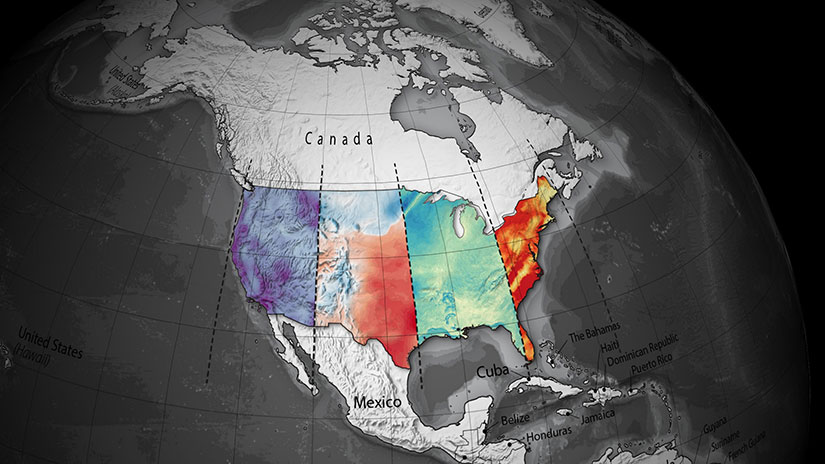Sup3r: Super-Resolution for Renewable Energy Resource Data
Developed by NREL, Sup3r is open-source software that transforms coarse, low-resolution data into actionable and accessible hyper-local data at unprecedented speed and scale.

Future humidity, temperature, wind, and solar data output from Sup3rCC. Graphic by Billy Roberts, NREL
Sup3r (pronounced “super”) is open-source software paired with publicly available datasets that leverages generative artificial intelligence to efficiently downscale global climate model data, improving resolution across space and time while preserving physical accuracy.
By dramatically cutting computational time and cost, Sup3r delivers the data needed for efficient, highly detailed energy system modeling and analysis.
How the Data Is Generated
Sup3r uses a generative machine learning approach to produce synthetic high-resolution spatiotemporal energy resource data from coarse, low-resolution inputs. Through this approach, Sup3r learns realistic spatial and temporal attributes of meteorological data by studying historical high-resolution datasets, including the National Solar Radiation Database and the Wind Integration National Dataset Toolkit. Based on patterns it learns, the model injects physically realistic small-scale information into the coarse data from global climate models—generating highly detailed temperature, humidity, wind speed, and solar irradiance data.
Applications of Sup3r
Sup3r supports a diverse range of applications that enable more accurate analysis and planning.
Sup3rCC is an application of the Sup3r software that downscales global climate model outputs to 4-km spatial and hourly temporal resolution. It provides high-resolution data on temperature, humidity, wind, and solar irradiance, supporting analysis of energy system resilience under future climate conditions. Notably, Sup3rCC does not represent real historical weather events, unlike Sup3rWind or Sup3rUHI (described below).
Sup3rWind uses the Sup3r software to produce high-resolution historical wind resource data by downscaling global reanalysis datasets—which combine historical weather observations with modern forecasting models—to 2-km spatial and 5-minute temporal resolution. It improves the representation of extreme wind events and preserves important spatiotemporal patterns for use in energy system planning and operations. Sup3rWind data is used by wind energy developers worldwide.
Sup3rUHI applies the Sup3r software to urban environments, combining satellite observations and ground measurements to generate hyper-local temperature and humidity time series. It supports both historical analysis and future scenario modeling, enabling precise, data-driven planning for high-risk heat events.
Future wind, solar, and temperature data output from a traditional global climate model (left) versus output from Sup3rCC (right)—showing the stark contrast in resolution. Graphic by Grant Buster, NREL
Access Sup3r
Precomputed Sup3r datasets are publicly available at no cost through the Open Energy Data Initiative.
Publications
High-Resolution Meteorology With Climate Change Impacts From Global Climate Model Data Using Generative Machine Learning, Nature Energy (2024)
Super Resolution for Renewable Energy Resource Data With Wind From Reanalysis Data (Sup3rWind) and Application to Ukraine, arXiv (2024)
Adversarial Super-Resolution of Climatological Wind and Solar Data, Proceedings of the National Academy of Sciences (2020)
Contact
Grant Buster
Share
Last Updated June 3, 2025
